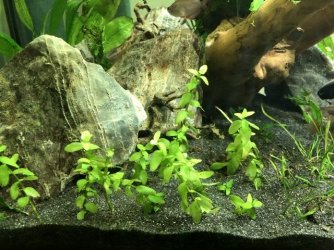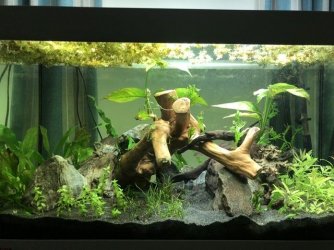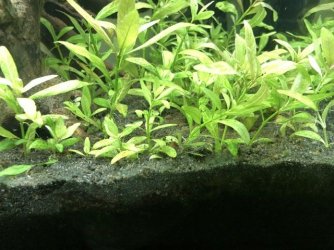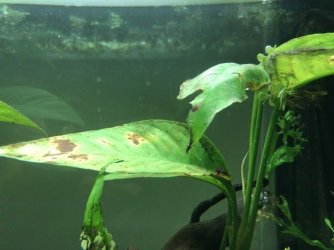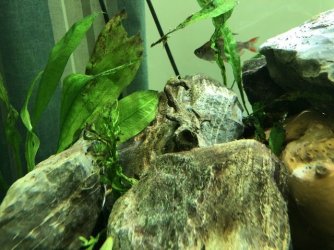Henry.ager
New Member
Hi,
I have been having a re-occurring algae/cyanobacteria problem in my fish tanks for years now and I am really struggling to keep looking after aquariums as it has been a very expensive and time consuming battle that I seem to be losing. In this post I am going to go into as much detail as possible to ask for help to diagnose and treat the problem and fix it.
History
This historically started around 12/13 years ago with my 30l biorb tank that I had as I was growing up. I had big cyanobacteria problem in this tank. 6/7 years ago I decided to start afresh and got a 60l fish tank that I set up with a new filter (TetraTec External EX800), new plants and substrate. I cycled this properly and added the fish in, but soon the same problem kept reoccurring forcing me to do massive cleans weekly. I bought my current tank ( a 120l tank) 3 years ago, again trying a fresh restart to clear the bacteria problem, however this time I used the same filter but gave it a really deep clean using Milton solution to try to kill any bacteria/algae. I also used the same heater with deep cleans. My problems with algae/bacteria persisted and I bought a new filter around 2 years ago. This didn't help, so around 10 months ago I decided to spend a lot of money on a new filter and filter media to try to have the cleanest water possible( this is in more detail below). Nothing changed so I decided to try to get some better lights and was given two lights from a friend, but these have not helped either.
My Tank

This was taken yesterday following a 2 hour cleaning session.
My tank is 120l tropical planted aquarium. Containing 8 Lemon Tetra, 2 Bolivian Rams and 1 lemon ancistrus. The fish are all very happy with the rams regularly spawning.
The plants also thrive whilst the algae/bacteria is not growing on the leaves. I recently got given some floating plants to try to soak up excess nutrients and they worked for a short while until the algae/bacteria started growing on them. They still grow well.
Filter
I have had this set up since June 2019. The filter I use is an Oase Biomaster Thermo 250 with seachem matrix as filter media on two layers plus seachem purigen, seachem matrix carbon and rowaphos. I clean the filter once every two months, washing the media in the aquarium water from a water change.
Water
Current Water parameters;
Temperature = 27.5 C
Ammonia NH4 = 0mg/l
Nitrate NO3 = 10
Nitrite NO2 = 0
KH = 10
GH = 8
pH = 7.6
Cl2 = 0
Phosphate = 1.0mg/l (which indicates my rowaphos needs changing and I shall do tomorrow)
Every morning I add 2ml of TNC Carbon, a liquid carbon, every day (they recommend 1ml per 50l) and 12ml of TNClite Aquarium Plant nutrient that contains potassium, magnesium and trace elements but no nitrate or phosphate one a week.
Lights
I have two aquael LED lights called LEDDY TUBE 16W SUNNY. These run from 0900 until 1600 so 7 hours.
The tank is also situated on the wall between two west facing windows so it definitely gets some sunlight during the afternoon.
Maintenance
I aim to clean the tank weekly, usually at weekends, however I am often away so can be left not cleaned until the Monday or Tuesday. I scrub all the glass with a toothbrush and then use the tooth brush to clean off the rocks, wood and any algae/bacteria that has grown on the plants. I then do a water change removing 15l and focusing on sucking up the mess from the clean and the debris on the floor around the plants. I then add around 20l of water back to the tank as I would have lost around 5l due to evaporation over the week.
Occasionally I miss a tank clean for a week and the tank goes two weeks without a clean, see photos below. In these circumstances I would remove 30l of water and top up around 40l. all water is from my tap and I add a chlorine remove into it before adding to the tank.
Photo of before tank clean



Photos after clean



Photos 1 day after tank clean


As you can see the algae/bacteria grows back to quickly its hard to keep on top of it.
Please any suggestions that you make are greatly received and I am happy to provide extra info if required.
Many Thanks,
Henry
I have been having a re-occurring algae/cyanobacteria problem in my fish tanks for years now and I am really struggling to keep looking after aquariums as it has been a very expensive and time consuming battle that I seem to be losing. In this post I am going to go into as much detail as possible to ask for help to diagnose and treat the problem and fix it.
History
This historically started around 12/13 years ago with my 30l biorb tank that I had as I was growing up. I had big cyanobacteria problem in this tank. 6/7 years ago I decided to start afresh and got a 60l fish tank that I set up with a new filter (TetraTec External EX800), new plants and substrate. I cycled this properly and added the fish in, but soon the same problem kept reoccurring forcing me to do massive cleans weekly. I bought my current tank ( a 120l tank) 3 years ago, again trying a fresh restart to clear the bacteria problem, however this time I used the same filter but gave it a really deep clean using Milton solution to try to kill any bacteria/algae. I also used the same heater with deep cleans. My problems with algae/bacteria persisted and I bought a new filter around 2 years ago. This didn't help, so around 10 months ago I decided to spend a lot of money on a new filter and filter media to try to have the cleanest water possible( this is in more detail below). Nothing changed so I decided to try to get some better lights and was given two lights from a friend, but these have not helped either.
My Tank
This was taken yesterday following a 2 hour cleaning session.
My tank is 120l tropical planted aquarium. Containing 8 Lemon Tetra, 2 Bolivian Rams and 1 lemon ancistrus. The fish are all very happy with the rams regularly spawning.
The plants also thrive whilst the algae/bacteria is not growing on the leaves. I recently got given some floating plants to try to soak up excess nutrients and they worked for a short while until the algae/bacteria started growing on them. They still grow well.
Filter
I have had this set up since June 2019. The filter I use is an Oase Biomaster Thermo 250 with seachem matrix as filter media on two layers plus seachem purigen, seachem matrix carbon and rowaphos. I clean the filter once every two months, washing the media in the aquarium water from a water change.
Water
Current Water parameters;
Temperature = 27.5 C
Ammonia NH4 = 0mg/l
Nitrate NO3 = 10
Nitrite NO2 = 0
KH = 10
GH = 8
pH = 7.6
Cl2 = 0
Phosphate = 1.0mg/l (which indicates my rowaphos needs changing and I shall do tomorrow)
Every morning I add 2ml of TNC Carbon, a liquid carbon, every day (they recommend 1ml per 50l) and 12ml of TNClite Aquarium Plant nutrient that contains potassium, magnesium and trace elements but no nitrate or phosphate one a week.
Lights
I have two aquael LED lights called LEDDY TUBE 16W SUNNY. These run from 0900 until 1600 so 7 hours.
The tank is also situated on the wall between two west facing windows so it definitely gets some sunlight during the afternoon.
Maintenance
I aim to clean the tank weekly, usually at weekends, however I am often away so can be left not cleaned until the Monday or Tuesday. I scrub all the glass with a toothbrush and then use the tooth brush to clean off the rocks, wood and any algae/bacteria that has grown on the plants. I then do a water change removing 15l and focusing on sucking up the mess from the clean and the debris on the floor around the plants. I then add around 20l of water back to the tank as I would have lost around 5l due to evaporation over the week.
Occasionally I miss a tank clean for a week and the tank goes two weeks without a clean, see photos below. In these circumstances I would remove 30l of water and top up around 40l. all water is from my tap and I add a chlorine remove into it before adding to the tank.
Photo of before tank clean
Photos after clean
Photos 1 day after tank clean
As you can see the algae/bacteria grows back to quickly its hard to keep on top of it.
Please any suggestions that you make are greatly received and I am happy to provide extra info if required.
Many Thanks,
Henry



